copyright
© 2010 Douglas Tong, all rights reserved
The following article is the first part of an interview with Såzen Larsen Kusano Sensei (5th dan) of the Sugino branch of Katori Shinto Ryu. In this article, Såzen Sensei tells us about a special ceremony he conducted here in Canada. Såzen Sensei is also a Zen Buddhist priest of the Soto Zen Buddhist tradition, having been ordained in Japan. For more information about Reverend Såzen and his Order, please visit his Order’s website: http://www.sotozen.no/international-norway.lasso
Part One: New Beginnings
Question: I understand that you conducted a special ceremony here in Canada?
Sensei: Yes, I did. I blessed the dojo of Sensei Dennis Wiens.
* Sensei Dennis Wiens, 1st dan, Katori Shinto Ryu (Sugino branch)
Question: Can you tell us more about it?
Sensei: Yes. Dennis told me that he wanted a name for his dojo. We thought about it, discussed it, and decided on a name. I wrote it and we got it framed. This marked a new beginning. And myself, being a Buddhist priest, it would not be so strange to do a blessing and an opening ceremony for a new place.
Dennis agreed to that and I guess being both a martial artist and a Buddhist priest, these things are not separate in my mind. We thought it would be a good idea to inaugurate the dojo.
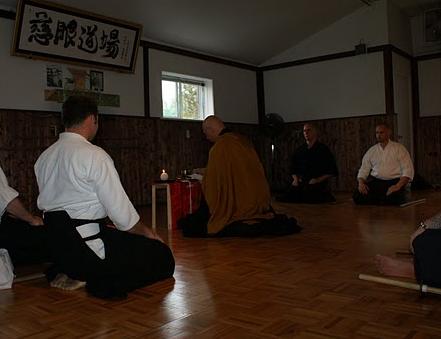
The inauguration ceremony
Question: Is there a certain form for this kind of event? A common type of ritual?
Sensei: Yes, I see. An interesting thing is that the word “dojo” derives from Buddhist culture. Dojo in the Buddhist sense is a place for worshipping Buddha and for practicing Zen. So a dojo is a sacred place for monks and nuns to practice and study. Not to study martial arts, but actually to study Buddhism.
Nowadays, the name “dojo” is still used in Buddhist monasteries and temples. But in the Western world and also in some parts of Asia and even parts of Japan, it is also a place for practicing such arts as tea ceremony (chadō), flower arrangement (kadō or ikebana), martial arts (budō), calligraphy (shodō), etc…
Having a new dojo, the building or opening of a new dojo, would be a natural thing. Even in Japan, for opening a new dojo, they would invite a Buddhist priest to bless it and perform the opening ceremony.
So in the blessing ceremony, as in most Buddhist ceremonies, we start with a wisdom chant and we offer incense.
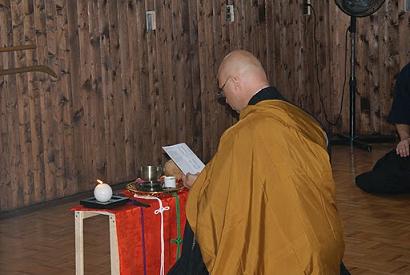
The wisdom chant (reciting the Heart Sutra)
Question: Sorry to interrupt but is there a significance to using incense?
Sensei: Well, it has a good smell! (laughs.)
Question: A good smell?
Sensei: Sure. It has a good aroma. In olden days, they didn’t have detergent and things were not as clean hundreds of years ago. So in some cases, the incense makes things smell good, smell better, makes it more tolerable, purifies.
* For more information on the history and uses of incense, see: Incense
Question: Is there any other significance to incense burning?
Sensei: Well, for Buddhists, it also reminds us of the famous Buddhist idea of form and no-form, form (as in substance) and no-form.
Question: What do you mean by this?
Sensei: Incense burning. It is form into formlessness.
Question: So, you perform a wisdom chant and burn incense to begin.
Sensei: Yes. The next step is the sound of bells. The bell is struck several times indicating that the priest and the other monks and nuns would begin to perform deep prostrations. They do this by putting their hands and heads to the ground and then lifting their hands up with their palms up. They stretch their bodies out.
They make three prostrations: standing up then going down. They perform these three prostrations (or bows) for three reasons:
Paying homage to Buddha
Question: Sorry to go back to an earlier point, but can you tell us about this wisdom chant?
Sensei: Sure. In the first part of the ceremony, we chant (or recite) the wisdom sutra. It is also known as the wisdom text. In our case with the blessing of Dennis’ dojo, we chanted the Heart Sutra, one of the most famous and more popular of the sutras from the Mahayana tradition.* We chant that to honour our great teacher of the doctrine, Buddha.
* For more information on Mahayana Buddhism, see: Mahayana Buddhism
After that would be the purification ritual. In this ritual, we take around the dojo a special tray called the “flower tray” containing incense and holy water.
Question: Holy water*?
Sensei: Yes. We make it holy. When you place ordinary water over incense with a prayer, it becomes holy. And with a special purification text, we walked around the dojo offering incense and sprinkling holy water. So that is purifying the dojo.
* some term it “blessed waters”, rather than holy.
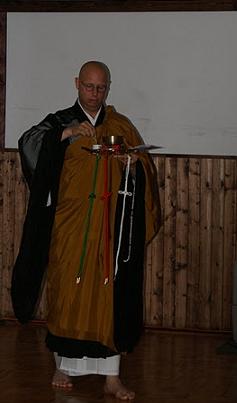
Purifying the dojo with holy water
Question: I see.
Sensei: Then, back at the altar, we sat down and did the “dojogei” - the dojo chant. We chanted for the dojo while offering incense and sounding the bells.
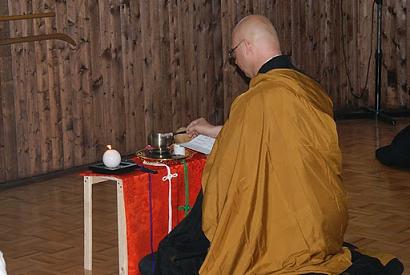
The ringing of the bell
The last part would be something called the “disaster prevention ritual”, for lack of a better word. This is a chant repeated three times. It is a special prayer for the safety of the place: safety from burglary, safety from fire, from flood and other accidents. Finally, we finish with bells and three prostrations and then the procession leaves.
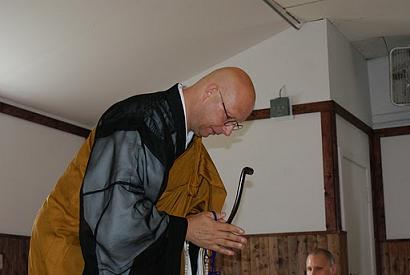
Homage to the Congregation
Question: Ah, I see. Thank you, sensei, for explaining this.
Sensei: You‘re welcome.
(To be continued…)
*For more information on Buddhism, see: Buddhism
Mr. Tong is the pioneer of Sugino-style Katori Shinto Ryu in Canada. He can be contacted via email at: doug@dragonfencing.com
The following article is the first part of an interview with Såzen Larsen Kusano Sensei (5th dan) of the Sugino branch of Katori Shinto Ryu. In this article, Såzen Sensei tells us about a special ceremony he conducted here in Canada. Såzen Sensei is also a Zen Buddhist priest of the Soto Zen Buddhist tradition, having been ordained in Japan. For more information about Reverend Såzen and his Order, please visit his Order’s website: http://www.sotozen.no/international-norway.lasso
Part One: New Beginnings
Question: I understand that you conducted a special ceremony here in Canada?
Sensei: Yes, I did. I blessed the dojo of Sensei Dennis Wiens.
* Sensei Dennis Wiens, 1st dan, Katori Shinto Ryu (Sugino branch)
Question: Can you tell us more about it?
Sensei: Yes. Dennis told me that he wanted a name for his dojo. We thought about it, discussed it, and decided on a name. I wrote it and we got it framed. This marked a new beginning. And myself, being a Buddhist priest, it would not be so strange to do a blessing and an opening ceremony for a new place.
Dennis agreed to that and I guess being both a martial artist and a Buddhist priest, these things are not separate in my mind. We thought it would be a good idea to inaugurate the dojo.
The inauguration ceremony
Question: Is there a certain form for this kind of event? A common type of ritual?
Sensei: Yes, I see. An interesting thing is that the word “dojo” derives from Buddhist culture. Dojo in the Buddhist sense is a place for worshipping Buddha and for practicing Zen. So a dojo is a sacred place for monks and nuns to practice and study. Not to study martial arts, but actually to study Buddhism.
Nowadays, the name “dojo” is still used in Buddhist monasteries and temples. But in the Western world and also in some parts of Asia and even parts of Japan, it is also a place for practicing such arts as tea ceremony (chadō), flower arrangement (kadō or ikebana), martial arts (budō), calligraphy (shodō), etc…
Having a new dojo, the building or opening of a new dojo, would be a natural thing. Even in Japan, for opening a new dojo, they would invite a Buddhist priest to bless it and perform the opening ceremony.
So in the blessing ceremony, as in most Buddhist ceremonies, we start with a wisdom chant and we offer incense.
The wisdom chant (reciting the Heart Sutra)
Question: Sorry to interrupt but is there a significance to using incense?
Sensei: Well, it has a good smell! (laughs.)
Question: A good smell?
Sensei: Sure. It has a good aroma. In olden days, they didn’t have detergent and things were not as clean hundreds of years ago. So in some cases, the incense makes things smell good, smell better, makes it more tolerable, purifies.
* For more information on the history and uses of incense, see: Incense
Question: Is there any other significance to incense burning?
Sensei: Well, for Buddhists, it also reminds us of the famous Buddhist idea of form and no-form, form (as in substance) and no-form.
Question: What do you mean by this?
Sensei: Incense burning. It is form into formlessness.
Question: So, you perform a wisdom chant and burn incense to begin.
Sensei: Yes. The next step is the sound of bells. The bell is struck several times indicating that the priest and the other monks and nuns would begin to perform deep prostrations. They do this by putting their hands and heads to the ground and then lifting their hands up with their palms up. They stretch their bodies out.
They make three prostrations: standing up then going down. They perform these three prostrations (or bows) for three reasons:
- they pay homage to Buddha.
- they pay homage for receiving the doctrine; by this, I mean they pay homage for receiving the teachings.
- they pay homage to the congregation.
Paying homage to Buddha
Question: Sorry to go back to an earlier point, but can you tell us about this wisdom chant?
Sensei: Sure. In the first part of the ceremony, we chant (or recite) the wisdom sutra. It is also known as the wisdom text. In our case with the blessing of Dennis’ dojo, we chanted the Heart Sutra, one of the most famous and more popular of the sutras from the Mahayana tradition.* We chant that to honour our great teacher of the doctrine, Buddha.
* For more information on Mahayana Buddhism, see: Mahayana Buddhism
After that would be the purification ritual. In this ritual, we take around the dojo a special tray called the “flower tray” containing incense and holy water.
Question: Holy water*?
Sensei: Yes. We make it holy. When you place ordinary water over incense with a prayer, it becomes holy. And with a special purification text, we walked around the dojo offering incense and sprinkling holy water. So that is purifying the dojo.
* some term it “blessed waters”, rather than holy.
Purifying the dojo with holy water
Question: I see.
Sensei: Then, back at the altar, we sat down and did the “dojogei” - the dojo chant. We chanted for the dojo while offering incense and sounding the bells.
The ringing of the bell
The last part would be something called the “disaster prevention ritual”, for lack of a better word. This is a chant repeated three times. It is a special prayer for the safety of the place: safety from burglary, safety from fire, from flood and other accidents. Finally, we finish with bells and three prostrations and then the procession leaves.
Homage to the Congregation
Question: Ah, I see. Thank you, sensei, for explaining this.
Sensei: You‘re welcome.
(To be continued…)
*For more information on Buddhism, see: Buddhism
Mr. Tong is the pioneer of Sugino-style Katori Shinto Ryu in Canada. He can be contacted via email at: doug@dragonfencing.com